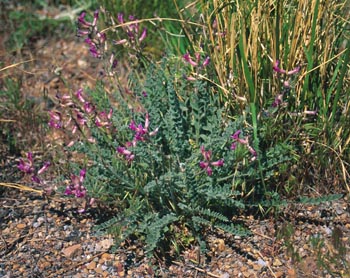Locoweed

Common Name(s):
Locoweed
Milkvetch
Poisonvetch
Astragalus
Scientific Name:
Astragalus L.
Scientific Name Synonyms:
ASTRA
Symbol:
symbol goes here
Description:
Life Span: Annual or Perennial
Origin: Native
Season: Cool
Growth Characteristics: An erect to prostrate forb, with stems that are mostly hairy and leafy. Astragalus species found in Utah fit into three different categories: 1) Those known not to be harmful to livestock, of which Cicer milkvetch is the only one; 2) Those harmful to livestock which produce teratogenisis and embryonic death, known as locoweeds; and 3) Those that accumulate selenium and thus cause damage to livestock, called Milkvetches. Locoweed starts growth in late fall, winter, or early spring. Milkvetches emerge from late April to June. Reproduces from seed.
Flowers/Inflorescence: Flowers resemble pea flowers, but smaller in size. Colors vary from white to yellow to blue to purple, and are arranged in a raceme.
Fruits/Seeds:A pea pod (legume) with a papery, leathery, or woody cover.
Leaves: Odd-pinnate leaves (a leaflet at the terminal end of the leaf), usually pubescent.
Ecological Adaptions:
Members of the Astragalus are commonly found on foothills and plains and in semiarid desert regions. They belong to the legume family and are capable of fixing nitrogen in the soil, thus building soil fertility.
Soils: Adapted to many soils, common in clay, sands, and gravel. Some species of locoweed are found in soils high in selenium.
Associated Species: Cheatgrass, sagebrush, fourwing saltbush, pinyon pine, Utah juniper.
Uses and Management:
Locoweed causes "loco" poisoning. Signs of poisoning appear after 2 to 3 weeks of continuous grazing on the plant. Prevent poisoning by avoiding patches of locoweed or removing sheep from infested areas of locoweed. Range improvement may be needed where locoweed occurs. Symptoms of poisoning include: crazed action, uncertainty of footing (high stepping), head held erect with excited appearance or low, blinking eyes, leaving the herd, abortion of fetus, inability to eat or drink, and paralysis. Horses that have been poisoned by locoweed have little value as saddle or draft animals. Beef cattle with prior poisoning may not make economic gains even though they may appear to recover.
The poison in milkvetches acts quickly. Some deaths occur within one hour, so fast that cattle show no signs. Usually animals die within 3 or 4 hours after eating the plant. Acute poisoning is characterized by a general muscular weakness. It paralyzes leg muscles so the affected animals fall after the slightest excitement, although they appear fine. The heart beats very rapidly before the animal dies from heart failure. Chronic intoxication may occur in animals grazing milkvetch species slowly over a period of several days or weeks. This type of poisoning is characterized by respiratory problems and varying degrees of posterior paralysis. Milkvetch is less dangerous after seed dispersal in July or August.

